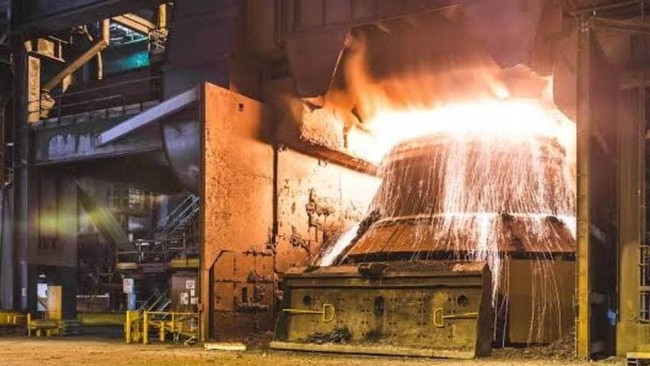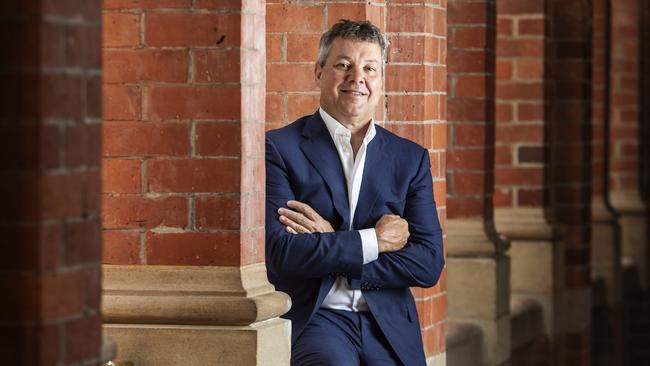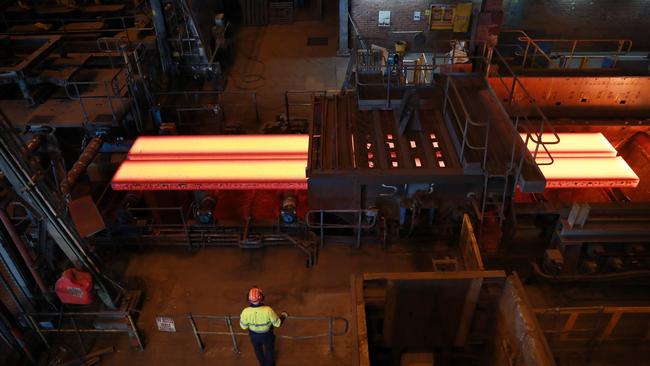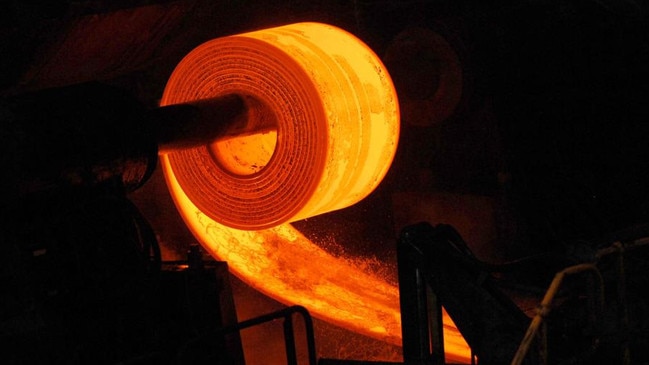Cheap Chinese steel and high energy costs heap pressure on BlueScope
Ensuring the survival of Australia’s steelmaking capacity will require ongoing co-operation from all levels of government, BlueScope boss Mark Vassella has warned.

Ensuring the survival of Australia’s steelmaking capacity will require tight co-operation from all levels of government, BlueScope steel managing director Mark Vassella says, with the company facing energy costs in some cases triple those of overseas rates and a deluge of cheap steel coming out of China.
Speaking to The Australian after the company reported a one fifth fall in full-year net profit and flagged further pain to come, Mr Vassella said plotting a decarbonisation pathway for the steel sector in Australia “is going to involve co-operation between state and federal governments, private practice, big energy companies, steel companies, it’s going to require co-operation across the board’’.
Mr Vassella said BlueScope’s energy prices in the US were sharply lower than in Australia, with the company paying about a third for gas there compared with here, and half the price for electricity.
Meanwhile, China last year sold 93 million tonnes of steel into world markets, with many Chinese operators likely running at close to break-even or actually losing money, he said.
Mr Vassella said BlueScope, which produces about three million tonnes of steel a year at its Port Kembla operations in New South Wales, was diversified into value-added products such as Colorbond which made it a more resilient business, but issues such as anti-dumping policies needed to stay front of mind for governments.
“We don’t ask for any favours, we just ask for free and fair trade,’’ Mr Vassella said.
“But subsidised steelmaking at that sort of level (in China) could destroy the domestic market, so we’ve argued strenuously, not only for us, but even down through the supply chain for our customers, around fabricated steel, to ensure that we’ve got an appropriate anti-dumping regime.’’

Mr Vassella said the system currently was appropriate, but the government needed to remain diligent, and BlueScope was looking forward to a new anti-dumping commissioner being announced.
On energy, BlueScope was keen to see “more supply and more suppliers’’, Mr Vassella said, with higher energy prices to cost the company $25m more in the current half against the same period last year.
“Quite frankly, we’re technology agnostic,’’ he said. “The issue for us is the sorts of businesses that we run – we need 24/7 power.
“So whilst the build out of renewables is fabulous, and we have a power purchase agreement with a solar farm in western NSW which is about 20 per cent of our power, we need power that’s dispatchable, available 24/7, not wind driven, not sun driven.
“We’ve talked to both sides of government about the importance of that baseload capacity that’s in the energy system to make sure that companies and industries like ours aren’t disadvantaged.
“We’re not there with battery technology yet. Unfortunately, the scale of the requirement of the Port Kembla steelworks is beyond the technology for batteries.
“We need dispatchable, affordable renewable energy .... and more supply and more suppliers, we think is helpful in terms of creating a functioning energy market.’’
Mr Vassella said inflationary pressures were also front of mind.
“We’ve come through a really tight supply chain period post-Covid where we’ve seen a whole bunch of cost increases so no different from the household cost pressures – businesses are seeing the same sorts of cost pressures.
“We’ve got to look at our business, to work out how we try and mitigate that and how we get it back.
“So lots of attention and focus in our business. How do we do things more efficiently for lower cost? How do we make more with less? That’s just part of the culture of being a manufacturer.’’

Mr Vassella said China’s steelmakers had continued to run at “really high levels of production’’ despite weakness in Chinese domestic construction, meaning that the excess was flowing into global markets and pushing steel spreads below what was considered historically the bottom of the cycle price-wise.
“We’ve seen a dynamic where China’s continued to run at really high levels of production, which has kept raw material costs up,’’ Mr Vassella said.
“And because of the soft domestic market, they’ve been exporting enormous amounts of steel … which has been driving steel prices down so we’ve had a spread squeeze and that’s resulted in the numbers that we’ve put forward.’’
Mr Vassella said he believed the Chinese operators were not operating sustainably.
“I think we’re now seeing steelmakers understand that the business model they have is not viable,’’ he said.
“And I suspect those steel companies in China are at cash break even or cash loss positions, quite frankly.
“So I think that’s why we started to see some pressure come on with iron ore, but there’s no question that the softness in China is going to drive an impact on iron ore costs, and that will ultimately flow through to us – not necessarily good outcomes but that will ultimately flow through to us.’’
Mr Vassella said the company had set up its Port Kembla operations over the past few years to ensure they would be cash break-even, including sustaining capital expenditure, at the bottom of the cycle, however prices were dipping below those levels.
“Now, what we’ve seen in the last six months is spreads actually go below the historical bottom of the cycle, down as low as $US150-odd dollars a tonne in Southeast Asia, which is extraordinarily low when we talk about a long run bottom of the cycle (which is) more like $US180 a tonne,’’ he said.
“But of course, spreads change from month to month to month, and sometimes when they get really low, it’s difficult to manage costs, particularly when you’ve got things like energy costs going up that you can’t immediately take action to try and fix.”

BlueScope on Monday reported a full-year net profit of $805.7m, down from $1.01bn, on revenue of $17.01bn, down 6 per cent.
The outlook would continue to be soft also, with the company expecting a substantial drop in underlying earnings for the first half of the current financial year.
BlueScope is forecasting earnings for the first half in the range of $350m-$420m, down from an underlying EBIT of $718m for the first half of last year.
Mr Vassella said strength in the company’s US steelmaking and global downstream operations had offset the impact of the weakness in Asia and in the Australian and New Zealand assets.
“Operating cash flow for the year, after capital expenditure, was $434m,’’ Mr Vassella said.
“This was lower than FY2023 due to slightly lower earnings, higher working capital, and higher capital expenditure, as we invest to secure long-term sustainable earnings and growth.
“Despite the lower operating cash flow, BlueScope again finished the year with a robust balance sheet, with $364m net cash.’’
Underlying earnings in the company’s Australian operations were 30 per cent lower at $376.9m.
“Domestic dispatches were softer in the year, predominantly driven by softer building and construction activity, as housing approvals contracted and the backlog from prior period was worked through,’’ the company said.
“Despite this softness, underlying demand for housing remains robust in the medium-term.’’
Underlying earnings in the North American division were just 3 per cent lower at $935.1m.
BlueScope will pay a fully-franked final dividend of 30c per share, up from 25c for the same period last year.
RBC Capital markets said the profit and revenue figures each missed consensus estimates by 3 per cent.
BlueScope shares fell 2.5 per cent early Monday to $20.01.






To join the conversation, please log in. Don't have an account? Register
Join the conversation, you are commenting as Logout